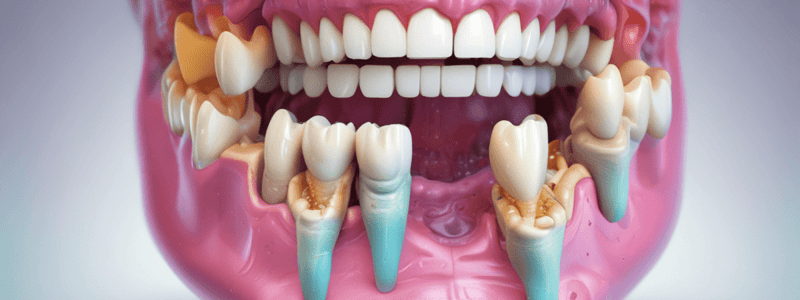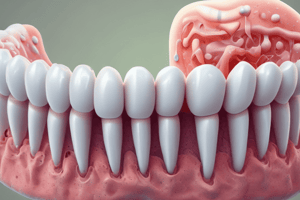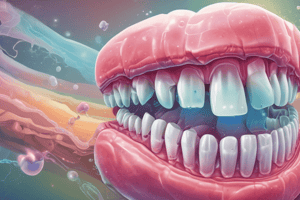Podcast
Questions and Answers
What is the primary mechanism by which tooth decay occurs?
What is the primary mechanism by which tooth decay occurs?
- Acid formation in dental plaque dissolving the enamel (correct)
- Mechanical damage to the enamel by chewing forces
- Inflammation of the gums leading to enamel loss
- Direct bacterial attack on the enamel
Which of the following hypotheses suggests that the bacteria that initiate caries are not original?
Which of the following hypotheses suggests that the bacteria that initiate caries are not original?
- Acid formation hypothesis
- Ecologic plaque hypothesis
- Specific plaque hypothesis
- Non-specific plaque hypothesis (correct)
What is the primary factor that determines the likelihood of tooth decay in an individual?
What is the primary factor that determines the likelihood of tooth decay in an individual?
- The genetic predisposition of the individual
- The rate of acid formation versus saliva wash (correct)
- The type of bacteria present in the plaque
- The frequency of sugar consumption
What is the purpose of the Stephan curve?
What is the purpose of the Stephan curve?
Which of the following bacteria is NOT primarily responsible for tooth decay?
Which of the following bacteria is NOT primarily responsible for tooth decay?
What is the term for the sudden drop in mouth pH that occurs after a glucose shock?
What is the term for the sudden drop in mouth pH that occurs after a glucose shock?
Which of the following is a characteristic of tooth decay?
Which of the following is a characteristic of tooth decay?
What is the term for the balance of microflora in the mouth that can lead to tooth decay?
What is the term for the balance of microflora in the mouth that can lead to tooth decay?
Which of the following bacteria is NOT a dominant species associated with caries?
Which of the following bacteria is NOT a dominant species associated with caries?
What is the primary reason why antibiotic chewing gums are not effective in preventing tooth decay?
What is the primary reason why antibiotic chewing gums are not effective in preventing tooth decay?
What is the best method for preventing tooth decay?
What is the best method for preventing tooth decay?
Why may people with bad oral hygiene have less dental caries?
Why may people with bad oral hygiene have less dental caries?
What is the primary mechanism by which anatomical malformations affect dental caries?
What is the primary mechanism by which anatomical malformations affect dental caries?
Why is oral hygiene important in preventing tooth decay?
Why is oral hygiene important in preventing tooth decay?
What is the primary function of bacteria in the process of caries formation?
What is the primary function of bacteria in the process of caries formation?
What is the main component of tooth enamel?
What is the main component of tooth enamel?
What is the result of acid dissolution of calcium salts in tooth enamel?
What is the result of acid dissolution of calcium salts in tooth enamel?
What type of bacteria are commonly found in individuals with caries?
What type of bacteria are commonly found in individuals with caries?
What is the characteristic of the decay process in dentin tissue?
What is the characteristic of the decay process in dentin tissue?
What is the result of the decomposition of organic matrix by bacteria?
What is the result of the decomposition of organic matrix by bacteria?
What is the primary difference between the flora of non-caries and caries individuals?
What is the primary difference between the flora of non-caries and caries individuals?
What is the role of cavitation in the decay process?
What is the role of cavitation in the decay process?
Study Notes
Tooth Decay
- Tooth decay is a progressive disease caused entirely by bacteria
- It is a chronic infection disease that can occur in both poor and rural areas, as well as in civilized societies
- Tooth decay occurs when the enamel is dissolved by acids produced by bacteria in the dental plaque
Caries Hypotheses
- Specific plaque hypothesis: S.mutans and S.sobrinus initiate caries
- Non-specific plaque hypothesis: the bacteria that start caries are not original
- Ecologic plaque hypothesis: permanent microflora balance deterioration leads to caries
Acid Formation in Dental Plaque
- Acid formation depends on the variety of bacteria in the plaque
- Acid and alcohols are formed from carbohydrates
- Saliva dilutes, washes, and buffers acid, but tooth decay occurs when acid-producing mechanisms overcome acid removal mechanisms
Glucose Shock
- Mouth pH drops due to 10% glucose solution given by healthy individuals and rinsing their mouths for 10 sec
- The Stephan curve is obtained by measuring the pH of the mouth at 30 sec intervals following a glucose shock
- The curve is different for each human, dental plaque, and cryogenic bacterium
Demineralization
- Bacteria convert carbohydrates into acids, which create caries
- pH of the environment drops, and tooth enamel, a calcified tissue, is dissolved
- Acid medium dissolves Ca salts, and the organic matrix (collagen) remains from demineralized enamel tissue (appearing white in color)
Cavitation
- In the later stages of decay, bacteria enter the microcavities of the demineralized enamel
- First, Laktobacilli and Streptococci bacteria enter, followed by increased acid production, making enamel repair impossible
- Event is irreversible, and dentin decay is more progressive
Decay-Forming Bacteria
- In children aged 1.5 to 7 years, non-caries individuals have S.mitis, S.oralis, S.sanguinis, and S.parasanguinis, while individuals with caries have Actinomyces spp, Lactobacillus spp, and S.mutans
- In deep caries of young permanent teeth, S.mitis, S.pneumoniae, S.infantis, and other bacteria are present
- The most dominant bacteria in caries are Lactobacillus, Veillonella, Bifidobacterium, Propionibacterium, Actinomyces, Atopobium, and S.mutans
Prevention of Dental Caries
- Protection from tooth decay is possible with removal of plaque and acids by toothbrush
- Using antiseptic and local antibiotics is incorrect
- Best method: Balanced diet, removal of plaques, and hygiene education
Dental Caries Immunology
- Oral hygiene proves that tooth decay is not a genetic disease
- Bacteria that cause caries are not genetically transmitted, they are transmitted from the oral environment and multiply
- Familial food consumption habits play a role in tooth decay
- People with bad oral hygiene may have less dental caries due to IgA against carcinogenic bacteria in saliva and effective non-specific immunity
Studying That Suits You
Use AI to generate personalized quizzes and flashcards to suit your learning preferences.
Related Documents
Description
This quiz covers the microbiology of tooth decay, its causes, and hypotheses. It explores the role of bacteria in tooth decay and the different hypotheses surrounding the disease.




